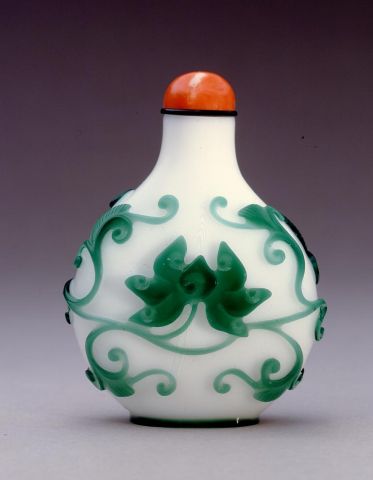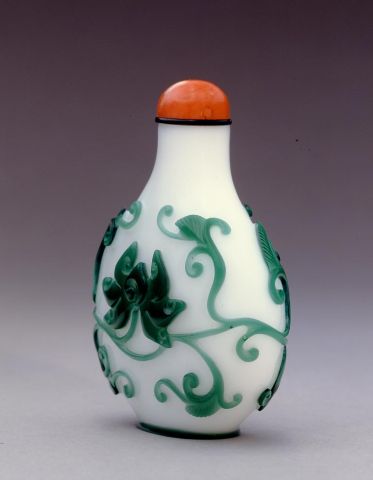

Bottle ID: 00392
WHITE W/GREEN OVERLAY, SCROLLING LOTUS FLOWERS
Date: 1750-1800
Height: 59 mm
Glass, of flattened rounded form with sloping shoulders, overlaid in emerald-green on a milk-white ground and continuously carved with scrolling lotus flowers and tendrils, the oval footrim also in emerald-green.
Imperial, attributed to the Palace Workshops, Beijing.
Similar Examples:
The Crane Collection no. 60.
Moss, Hugh, Victor Graham and Ka Bo Tsang. The Art of the Chinese Snuff Bottle - The J & J Collection, 1993, Vol. 2, p. 625, no. 378.
Moss, Hugh, Victor Graham and Ka Bo Tsang. A Treasury of Chinese Snuff Bottles - The Mary and George Bloch Collection, 2002, Vol. 5, Part 2, p. 483, no. 901.
Provenance:
Clare Lawrence Ltd.
The Monimar Collection
Clare Lawrence Ltd.
Hugh Moss [HK] Ltd.
Exhibited:
Annual Convention ICSBS Toronto, October 2007
Christie's, St. James's, London, June 1996
Annual Convention ICSBS Hong Kong, October 1996
Published:
Lawrence, Clare. Miniature Masterpieces from the Middle Kingdom - The Monimar Collection of Chinese Snuff Bottles, 1996, pp. 258-259, no. 123.112.
It is tempting to view this bottle as replicating the style of carving, particularly seen on jade, depicted on the favored Moghul pieces from India and acquired by the Qianlong Emperor in the middle of the eighteenth century. However, the scrolling lotus design was ubiquitous on Chinese underglaze blue and white porcelain from the fourteenth century onwards, which in turn had been derived from designs on Near and Middle Eastern ceramics which had found their way into China. This Crane glass overlay is intriguing in that the design appears to be more related to the porcelain of the fourteenth century than to its eighteenth century porcelain counterpart. The Percival David Foundation in London houses an underglaze blue and white lobed porcelain plate from the Yuan dynasty (14th century) which has a central design of three classic scrolling lotuses and which bears a direct comparison with this decoration in its looseness and fluidity. (PDF No. B684). Later, decoration of both the Ming and Qing dynasties become gradually more detailed and exuberant in their execution of the same elements. Perhaps the inspiration for this bottle is found in a combination of decoration on those earlier porcelains and the Moghul patterns that the Qianlong Emperor particularly preferred.

 English
English 中文
中文